by Lisa Di Tommaso | Aug 10, 2019 | Blog
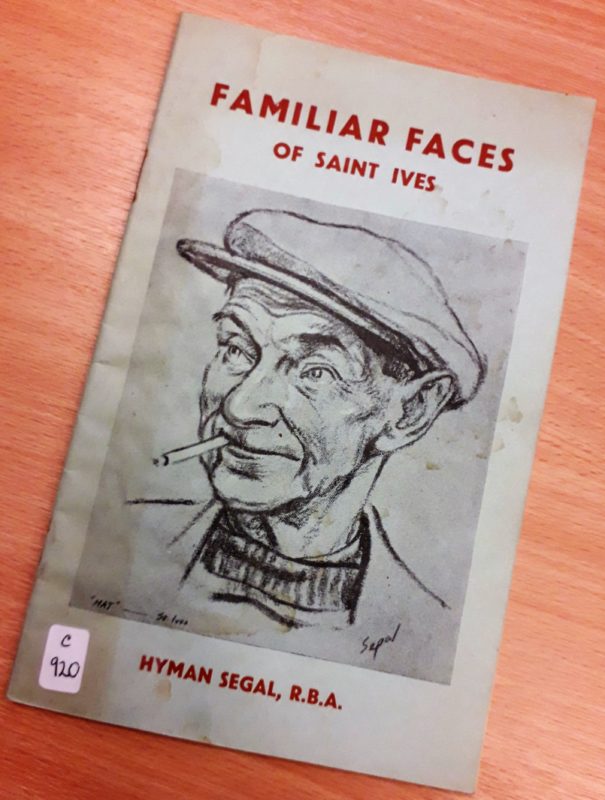
The library has recently received a charming donation. Titled Familiar Faces of St Ives, this uniquely illustrated pamphlet of around 20 pages offers a brilliant summary of life in St Ives just after the War – the town’s ‘Silver Age’ it might be termed. This fascinating time period is manifest in the vivid sketches by the well-known St Ives artist, Hyman Segal. https://cornwallartists.org/cornwall-artists/hyman-segal
Segal is probably best remembered for his African paintings as well as for his skill in portraying cats with sweeping economical lines. A Daily Mirror photographic frontispiece shows him, an Art Therapist at West Cornwall Hospital, helping the recovery of a young lad at Tehidy Sanatorium in Camborne. This classic photograph by Bela Zola indicates the pride in the newly created NHS (Zola was a leading photographer who recorded later the Aberfan Disaster and the Profumo Affair among other renowned assignments.) https://www.worldpressphoto.org/collection/photo/1956/28663/1/1956-Bela-Zola-GN1-(1)
The first sketch in the pamphlet is of our celebrated Town Crier, Abraham Curnow – here just 54 years old. This is accompanied by a sketch of his Father-in-Law, Ernest James Stevens, popularly known as “Jimmy Limpets”. This drawing with others by Segal now hangs in the Sloop Inn.
On the following page is an image of Thomas Tonkin Prynne who had been the manager of Lanham’s picture framing business which in previous years supplied the Royal Academy and other galleries with canvases by inter alia , Julius Olsen, Louis Grier and Moffat Linder. In addition to running an efficient business, he worked for 16 years as a member of the volunteer fire brigade, had a blue Persian cat and loved fishing.
There is also a magnificent sketch of Alistair St Clair Harrison, like Churchill, an old Harovian who had been a fighter pilot during the Second World War. It was Harrison who broadcast for the BBC about the rescue of HMS Wave in September 1952 and also about his interest in Antarctic whaling. It was with his Norwegian wife that he established “The Gay Viking”; almost as famous for its colourful clientele as its innovative continental cuisine. (Gay Viking was incidentally one of eight vessels that were ordered by the Turkish Navy, but were requisitioned by the Royal Navy to serve with Coastal Forces during the Second World War).
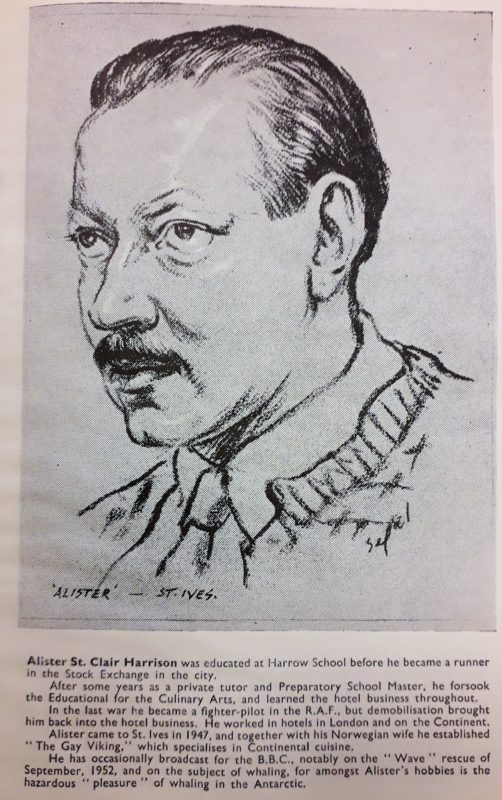
Frank Edward Endell Mitchell, appropriately portrayed with bow-tie, fashionable in the 1950’s, was known as “Micheal” and was the tenant of the Castle Inn. His friendship with Dylan Thomas must have been firmly established in the bohemian atmosphere of the bar there, then opposite Lanham’s and the Scala Cinema (presently Boots). Mitchell, who was the brother I believe, of the eminent sculptor, Denis Mitchell, offered the Castle lounge for the display of art works and in his spare time, he himself did pastels and was occupied in breeding Boxer dogs.
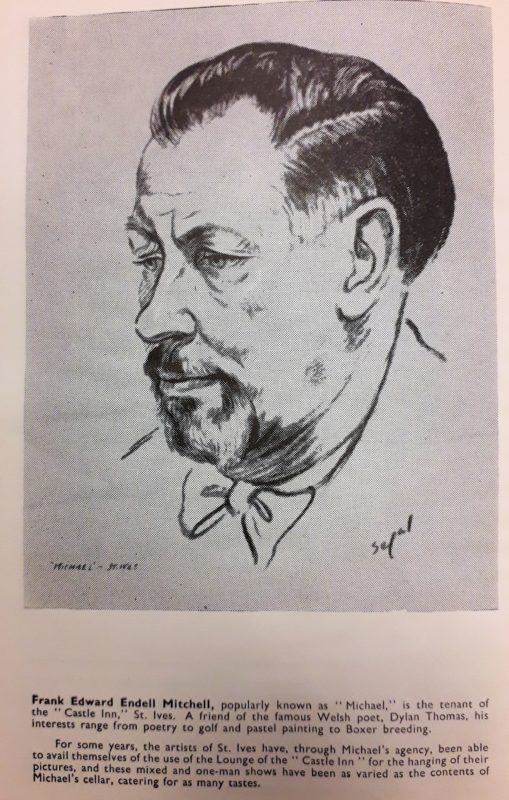
The donation of this little pamphlet to the Morrab Archive offers members the opportunity to recreate for themselves the ambience of the Fifties through “The Familiar Faces of St Ives”.
George Care, Library Member and Trustee
by admin | May 22, 2019 | Blog, News
A hidden treasure revealed
By Tehmina Goskar
Song of the Chough
Black is the Chough’s colour,
Red are its singing beak and legs,
Still alive on Cornish cliffs,
Although people say it is dead.
He is not dead,
He is not dead,
King Arthur is not dead!
This is the translation of a remarkable Cornish song found tucked away in the Jenner Room in the Morrab Library. While examining the music pamphlets drawer for something completely other, I came across two slips of paper in an original copy of Dr Ralph Dunstan’s Cornish Dialect and Folk Songs, 1932. One is a letter from Dunstan to Henry Jenner, father of the Cornish language revival and founding bard of Gorsedh Kernow. The other is a beautifully penned musical manuscript of a song called Can Palores (Chough’s Song) composed (or arranged) by Dunstan. The book was inscribed by Dunstan to Jenner, dated 16 July 1932.
Dr Ralph Dunstan was born in Carnon Downs on 17 November 1857. He learned to play the bassoon, violin, organ and more. Dunstan became a music teacher at Westminster Training College and won a doctorate from Cambridge. He published widely on the theory of music and in particular composition and harmony. Dunstan was also a Cornishman, alive during an incredibly vibrant period for the Celtic-Cornish movement that saw the establishment of the first Old Cornwall Society in St Ives in 1920, the Federation of Old Cornwall Societies in 1924, and Gorsedh Kernow in 1928. He spent his retirement devoted to Cornish musical matters.
The musical manuscript found at the Morrab is fleeting, barely 12 bars long. It is scored in D major and seems to be arranged for harmony singing—arrangements familiar to those who have studied Dunstan’s other arrangements of Cornish songs (see his Cornish Song Book or Lyver Canow Kernewek, 1929).
The last line of the refrain, ‘King Arthur is not dead!’ is a motto that we find on some Cornish language publications of this period and it appears with a chough in the middle forming an emblem. The imagery and the words are tied up with the Cornish lore of King Arthur whose soul is said to reside in a Cornish chough.
Robert Morton Nance, a key protagonist of the Cornish movement, and a correspondent of Dunstan, used this emblem on several of his pamphlets. Dunstan himself became deeply interested in Arthurian ballads when he moved back to Cornwall.

Its single verse, in the style of Cornish that was being used for the language revival in the 1920s, suggests there were others. A search in the newspaper archives gives us an intriguing clue as to what this song might have been used for. The Western Morning News of 17 September 1932 contains an article by a correspondent called Cornishwoman. It describes a Celtic song, dance and theatrical concert performed at the Royal Institution of Cornwall, Truro under Dunstan’s direction.
The article refers to a Cornish interlude called An Balores (the Chough) in which Phoebe Nance took part. Phoebe Nance (Morwennol—Sea Swallow) from Carbis Bay was made a bard of the Gorsedh the week before. Could it have been Phoebe that performed Can Palores during her interlude? The evidence is compelling. In the same year, 1932, Robert Morton Nance (Mordon) – Phoebe’s father –published a short play called An Balores and it ends with a three-verse song that finishes with the refrain, “Nyns yu marrow Myghtern Arthur!”
The letter, dated 18 July 1932, leaves a clue to the vast collection of unpublished material that Dunstan said he still had in his possession. “I have many other Cornish Songs of various kinds – several from Jim Thomas — I see no hope of ever publishing them in complete form with accompaniments.” Jim Thomas was a massively important figure for Dunstan during his collection of Cornish music and song of the type that took place in village halls, at chapel tea treats and mostly, in pub sessions up and down the Duchy. He goes on to describe the kind of book he would have liked to have published next, a Pocket Companion of Cornish Songs, and what would be in it. The letter itself does not refer to Can Palores.
Ralph Dunstan died on 2 April 1933, not long after writing the letter to Henry Jenner, and his Pocket Companion was never published. Dunstan’s own personal archive was apparently either burned by his daughter after his death or according to another report, left to go damp in a garden gazebo. Whichever is true, these two original survivals become all the more precious.
Can Palores
An Balores du hy lyw,
Ruth ha’y gelvyn can ha’y gar-row,
War als Ker-now whath a vew,
Kyn leverer hy bos marrow.
Nyns yu marrow,
Nyns yu marrow,
Nyns yu marrow Myghtern Arthur!
(Translation above courtesy of Cornish Language Office, Cornwall Council).
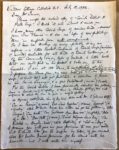
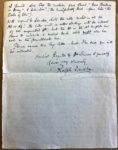
For information on interpreting the music and understanding Ralph Dunstan’s context, our sincere thanks to:
– Merv Davey, Folk Songs & amp; Music Recorder, Federation of Old Cornwall Societies
– Anna Dowling, Violinist, Singer and Composer
– Steve Penhaligon, Keur Heb Hanow
– Karin Easton, Perranzabuloe Museum and President of Federation of Old Cornwall Societies
– Pol Hodge, Cornish language scholar and poet, Golden Tree Productions
Tehmina Goskar, May 2019. For correspondence: tehmina@goskar.com






